#infrared astrophysics
Text
VP Harris, South Korea President Visit NASA Goddard
VP Harris & South Korea President Yoon visited NASA Goddard to observe climate change missions, TEMPO & GEMS, and the Nancy Grace Roman Space Telescope. #NASA #climatechange #spaceexploration #TEMPO #GEMS #NancyGraceRomanSpaceTelescope

View On WordPress
#climate change#dark energy#dark matter.#GEMS mission#infrared astrophysics#joint statement of intent#NASA Goddard#South Korea President#space exploration#TEMPO mission#VP Harris
2 notes
·
View notes
Text
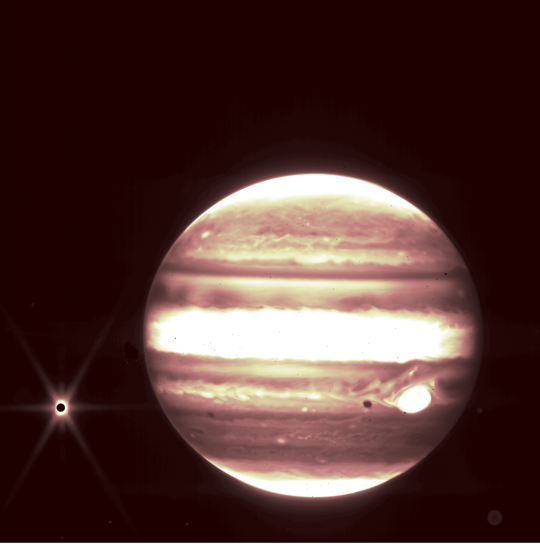
Credits: NASA, ESA, CSA, and B. Holler and J. Stansberry (STScI)
Jupiter, center, and its moon Europa, left, are seen through the James Webb Space Telescope’s NIRCam instrument 2.12 micron filter.
#nasa#space#astronomy#science#astrophotography#jwst#astrophysics#james webb space telescope#jupiter#planet#solar system#infrared#europa#moon#nircam#cosmos#my post#planets#rename jwst#RenameJWST
646 notes
·
View notes
Text
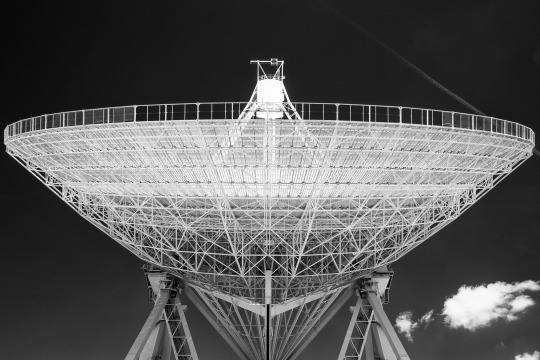
Radioteleskop Effelsberg
#Effelsberg#Eifel#radiotelescope#radio telescope#radio astronomy#astronomy#physics#infrared#infrated#infrarot#ir#astrophysics#observatory
7 notes
·
View notes
Text

Jupiter and Ring in Infrared from Webb
#space#nasa#astrophysics#outerspace#physics#astronomy#astrophotography#science#moon#galaxy#universe#solar system#jupiter#planetary rings#planet#planet jupiter#infrared#james webb images#james webb telescope
46 notes
·
View notes
Text
I think my physics teacher need to relearn the meaning of ‘near by’.
‘Oh yeah Andromeda is near by, it’s only 2.5 million light years away’
SIR!! NEAR BY IS DOWN THE ROAD!! NOT UNFATHOMABLE DISTANCES IN SPACE!!
#don’t do astrophysics unless you want your mind blown on a daily basis#black holes bend fucking space time around them#photos bend around the singularity so if you were there you could see the back of your head#we have telescopes the size of earth#there’s literally nothing stopping us seeing in infrared#sure it’s be blurry af because we have tiny eyes#but still fucking awesome#also andromeda is visible from earth#it’s just too dim for the naked eye#but long exposure camera could probably get it#there’s a star going round the black hole in the middle of our galaxy at 8% the speed of light#that’s something like 24 million metres per second#space#broke#my#brain#physics
3 notes
·
View notes
Link
4 min read A Solar Neighborhood Census, Thanks to NASA Citizen Science This artist’s conce...
#originaltags#astrophysics division#brown dwarfs#citizen science#neowise#stars#the universe#wise (wide-field infrared survey explorer)
0 notes
Text
Webb’s Infrared Eye Reveals the Heart of the Milky Way
Evan Gough - Webb’s Infrared Eye Reveals the Heart of the Milky Way:
#jameswebb#spacetelescope#telescope#jwst#infrared#nircam#galacticcenter#milkyway#sagittariusc#infrareddarkcloud#idc#highvelocitycompactcloud#hvcc#supernovaremnant#snr#astrophysics#infraredastronomy#astronomy
0 notes
Text
Você já se perguntou se existe vida fora da Terra? Se sim, você não está sozinho. Muitos cientistas e curiosos buscam por planetas que possam abrigar seres vivos, seja dentro ou fora do nosso sistema solar. Neste post, vamos apresentar sete lugares que têm grandes chances de ter vida, baseados nas últimas descobertas da astronomia.
#James Webb Space Telescope#Webb Space Telescope#NASAWebb#JWST#Webb#Trappist#Trappist-1#telescope#pizza#infrared#exoplanet#planet#rocky planet#Astronomy#astrophysics#atmosphere#space#science#universe
0 notes
Text
WHY IS THE SPACE BLACK??
Blog#306
Saturday, June 17th, 2023
Welcome back,
Look up at the night sky with your own eyes, or marvel at images of the universe online, and you'll see the same thing: the inky, abysmal blackness of space, punctuated by bright stars, planets or spacecraft. But why is it black? Why isn't space colorful, like the blue daytime sky on Earth?
Surprisingly, the answer has little to do with a lack of light.
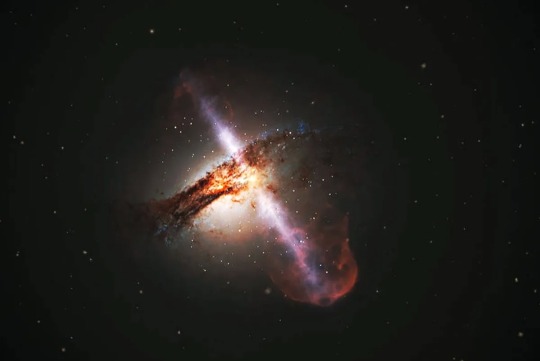
"You would think that since there are billions of stars in our galaxy, billions of galaxies in the universe and other objects, such as planets, that reflect light, that when we look up at the sky at night, it would be extremely bright," Tenley Hutchinson-Smith, a graduate student of astronomy and astrophysics at the University of California, Santa Cruz (UCSC), told Live Science in an email. "But instead, it's actually really dark."

Hutchinson-Smith said this contradiction, known in physics and astronomy circles as Olbers' paradox, can be explained by the theory of space-time expansion — the idea that "because our universe is expanding faster than the speed of light … the light from distant galaxies might be stretching and turning into infrared waves, microwaves and radio waves, which are not detectable by our human eyes."

And because they are undetectable, they appear dark (black) to the naked eye.
That said, a 2021 study in The Astrophysical Journal suggests that space may not be as black as scientists originally thought. Through NASA's New Horizons mission to Pluto and the Kuiper Belt, researchers have been able to see space without light interference from Earth or the sun.

The team sifted through images taken by the spacecraft and subtracted all light from known stars, the Milky Way and possible galaxies, as well as any light that might have leaked in from camera quirks. The background light of the universe, they found, was still twice as bright as predicted.

The reasons for the additional brightness, which remain unknown, will be the focus of future studies. Until then, one thing seems likely: Space could very well be more "charcoal" than pitch-black.
Originally published on big livescience.com
COMING UP!!
(Wednesday, June 21st, 2023)
"WHY IS DARK MATTER SO IMPORTANT??"
#astronomy#outer space#alternate universe#astrophysics#spacecraft#universe#white universe#parallel universe#space#astrophotography
306 notes
·
View notes
Link
2 min read Hubble Glimpses a Bright Galaxy Group This new NASA Hubble Space Telescope image shows a tangled group of interacting galaxies called LEDA 60847. NASA/ESA/A. Barth (University of California – Irvine)/M. Koss (Eureka Scientific Inc.)/A. Robinson (Rochester Institute of Technology)/Processing: Gladys Kober (NASA/Catholic University of America) This new NASA Hubble Space Telescope image shows a group of interacting galaxies known as LEDA 60847. LEDA 60847 is classified as an active galactic nuclei, or AGN. An AGN has a supermassive black hole in the galaxy’s central region that is accreting material. The AGN emits radiation across the entire electromagnetic spectrum and shines extremely brightly. By studying powerful AGNs that are relatively nearby, astronomers can better understand how supermassive black holes grow and affect galaxies. Galaxy mergers are relatively common occurrences. Most larger galaxies are the result of smaller galaxies merging. The Milky Way itself contains traces of other galaxies, indicating it is the product of past mergers. Astronomers believe somewhere between 5% and 25% of all galaxies are currently merging. This image of LEDA 60847 combines ultraviolet, visible, and near-infrared data from Hubble. The ability to see across all those wavelengths is one of the things that makes Hubble unique. Different types of light across the electromagnetic spectrum tell astronomers different things about our universe. Ultraviolet light traces the glow of stellar nurseries and is used to identify the hottest stars. Visible light shows us moderate-temperature stars and material, and also how the view would appear to our own eyes. Last but not least, near-infrared light can penetrate cold dust, allowing us to study warm gas and dust, and relatively cool stars. LEARN MORE: Hubble’s Cosmic Collisions Hubble Science: Galaxy Details and Mergers Hubble Science: Tracing the Growth of Galaxies Download this image Media Contact: Claire AndreoliNASA’s Goddard Space Flight Center, Greenbelt, [email protected] Share Details Last Updated Jan 23, 2024 Editor Andrea Gianopoulos Location Goddard Space Flight Center Related Terms Active Galaxies Astrophysics Division Galaxies Goddard Space Flight Center Hubble Space Telescope Missions The Universe Keep Exploring Discover More Topics From NASA Hubble Space Telescope Since its 1990 launch, the Hubble Space Telescope has changed our fundamental understanding of the universe. Galaxies Stories Stars Stories James Webb Space Telescope Webb is the premier observatory of the next decade, serving thousands of astronomers worldwide. It studies every phase in the…
59 notes
·
View notes
Text

"This new image of NGC 2264, also known as the 'Christmas Tree Cluster,' shows the shape of a cosmic tree with the glow of stellar lights. NGC 2264 is, in fact, a cluster of young stars — with ages between about one and five million years old — in our Milky Way about 2,500 light-years away from Earth. The stars in NGC 2264 are both smaller and larger than the Sun, ranging from some with less than a tenth the mass of the Sun to others containing about seven solar masses.
This new composite image enhances the resemblance to a Christmas tree through choices of color and rotation. The blue and white lights (which blink in the animated version of this image) are young stars that give off X-rays detected by NASA’s Chandra X-ray Observatory. Optical data from the National Science Foundation’s WIYN 0.9-meter telescope on Kitt Peak shows gas in the nebula in green, corresponding to the 'pine needles' of the tree, and infrared data from the Two Micron All Sky Survey shows foreground and background stars in white. This image has been rotated clockwise by about 160 degrees from the astronomer’s standard of North pointing upward, so that it appears like the top of the tree is toward the top of the image.

Young stars, like those in NGC 2264, are volatile and undergo strong flares in X-rays and other types of variations seen in different types of light. The coordinated, blinking variations shown in this animation, however, are artificial, to emphasize the locations of the stars seen in X-rays and highlight the similarity of this object to a Christmas tree. In reality the variations of the stars are not synchronized.
The variations observed by Chandra and other telescopes are caused by several different processes. Some of these are related to activity involving magnetic fields, including flares like those undergone by the Sun — but much more powerful — and hot spots and dark regions on the surfaces of the stars that go in and out of view as the stars rotate. There can also be changes in the thickness of gas obscuring the stars, and changes in the amount of material still falling onto the stars from disks of surrounding gas.
NASA’s Marshall Space Flight Center manages the Chandra program. The Smithsonian Astrophysical Observatory’s Chandra X-ray Center controls science operations from Cambridge, Massachusetts, and flight operations from Burlington, Massachusetts."
Date: December 19, 2023
NASA ID: link
#NGC 2264#Christmas Tree Cluster#Space#Galaxy#NASA#December#2023#gif#Chandra X-ray Observatory#X-ray Observatory#Chandra#Marshall Space Flight Center#MSFC#Huntsville#Alabama#my post
60 notes
·
View notes
Text
VP Harris and South Korea President to Visit NASA Goddard for Climate Change Work
Vice President Kamala Harris gives remarks in front of the Space Environment Simulator (SES) at NASA’s Goddard Space Flight Center in Greenbelt, Md., in 2021.Credits: NASA/Taylor Mickal
On April 25th, 2023, Vice President Kamala Harris and President Yoon Suk Yeol of South Korea will be visiting NASA’s Goddard Space Flight Center in Greenbelt, Maryland. The purpose of their visit is to witness…

View On WordPress
#air quality#climate change#dark energy#dark matter#exoplanets#GEMS mission#Goddard Space Flight Center#infrared astrophysics#Kamala Harris#NASA#scientific research#South Korea#TEMPO mission#Yoon Suk Yeol
0 notes
Text
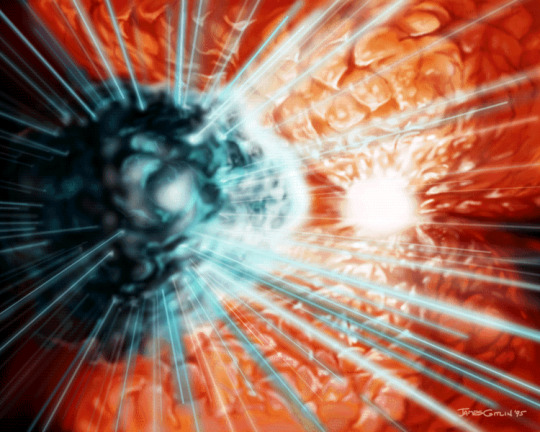
Lasers in Eta Carinae - January 11th, 1996.
"Have you heard about the great LASER light show in the sky? Well, nobody had until it was announced on January 10th, 1996, by a team led by K. Davidson (U. Minnesota) and S. Johansson (U. Lund). The research team discovered that the unusually variable star Eta Carinae emits ultraviolet light of such a specific colour, it was guessed to most probably be LASER light! The artist's conception shown above depicts a model for the Hubble Space Telescope observations. In this model, Eta Carinae emits many LASER beams from its surrounding cloud of energised gas. Infrared LASERS and microwave MASERS are extremely rare astrophysical phenomena, but this ultraviolet LASER was the first of its kind to be discovered."
48 notes
·
View notes
Text

Second biggest full movable radio telescope in the world
#Eifel#infrated#infrared#clouds#space#radiotelescope#observatory#radio#astronomy#radio astronomy#astrophysics
0 notes
Text
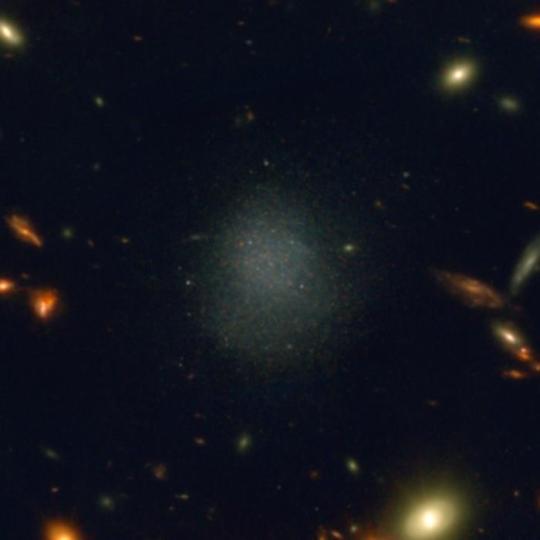
Astronomers make a serendipitous discovery of a galaxy that shouldn’t exist
A team of astronomers, led by Arizona State University Assistant Research Scientist, Tim Carleton, has discovered a dwarf galaxy that appeared in James Webb Space Telescope (JWST) imaging that wasn’t the primary observation target.
Galaxies are bound together by gravity, and are made up of stars and planets, with vast clouds of dust and gas as well as dark matter. Dwarf galaxies are the most abundant galaxies in the Universe, and are by definition small with low luminosity. They have fewer than 100 million stars, compared to the Milky Way that has nearly 200 billion stars. Recent dwarf galaxy observations of the large abundance of “Ultra-Diffuse Galaxies” beyond the reach of previous large spectroscopic surveys suggest that our understanding of the dwarf galaxy population may be incomplete.
In a newly published study, Carleton and the team were initially looking at a cluster of galaxies as part of the JWST Prime Extragalactic Areas for Reionization and Lensing Science (PEARLS) project. The dwarf galaxy, PEARLSDG, happened to appear in some of the team’s JWST imaging - it wasn’t the target at all; just a bit off from the main observation field, in the area of space where they weren't expecting to see anything. Their results have been published in the Astrophysical Journal Letters.
PEARLSDG did not have the usual characteristics of a dwarf galaxy one would expect to see - it isn't interacting with a nearby galaxy, but it also isn't forming new stars. As it turns out, it is an interesting case of an isolated quiescent galaxy.
“These types of isolated quiescent dwarf galaxies haven't really been seen before except for relatively few cases - they are not really expected to exist given our current understanding of galaxy evolution, so the fact that we see this object helps us improve our theories for galaxy formation,” said Carleton. “Generally, dwarf galaxies that are out there by themselves are continuing to form new stars.”
Until now, astronomers' understanding of galaxy evolution showed an isolated galaxy that continued to form young stars or it would interact with a more massive companion galaxy. The built up theory of evolution of galaxies didn’t apply to PEARLSDG - that by happenstance appeared out of nowhere. PEARLSDG presents as an old stellar population, not forming new stars as well as keeping to itself.
In a further surprise, individual stars can be observed in the team’s JWST images. These stars are brighter in JWST wavelengths - it is one of the farthest galaxies that we can see these stars with this level of detail. The brightness of these stars allows astronomers to be able to measure its distance - 98 million light years.
For this study, Carleton, who is an assistant research scientist at the Beus Center for Cosmic Foundations in the School of Earth and Space Exploration at ASU, used a wide range of data. This includes imaging data from JWST’s Near-InfraRed Camera (NIRCam), spectroscopic data from the DeVeny Optical Spectrograph on the Lowell Discovery Telescope (LDT) in Flagstaff, AZ, archival imaging from NASA’s Galex and Spitzer space telescopes, as well as ground-based imaging from the Sloan Digital Sky Survey and the The Dark Energy Camera Legacy Survey.
JWST’s NIRCAM has very high angular resolution and sensitivity, allowing the team to identify individual stars in this distant galaxy. Just like individual cells coming into focus in a microscope, these observations brought the components of PEARLSDG into sharp focus. Importantly, identifying specific stars in the imaging provided a key clue to its distance — these stars have a specific intrinsic brightness, so by measuring their apparent brightness with JWST, the team was able to determine how far away they are. It turns out that these stars were some of the most distant stars of their type to be observed!
All of the archival imaging data, observing at ultraviolet, optical, and infrared wavelengths, was pulled together to study the color of PEARLSDG. Newly formed stars have a specific color signature, so the absence of such a signature was used to show that PEARLSDG was not forming new stars.
The DeVeney Spectrograph at the LDT spreads the light astronomical objects into its distinct components, allowing astronomers to study its properties in detail. For example, the specific wavelength shift observed in features in the spectroscopic data encodes information about the motion of PEARLSDG, using the same “doppler effect” that radar guns use to measure the speed of drivers on Arizona roads. This was key to show that PEARLSDG is not associated with any other galaxy and is truly isolated. Additionally, particular features in the spectrum are also sensitive to the presence of young stars, so the absence of those features further corroborated the measurements of the absence of young stars from imaging data.
“This was absolutely against people's expectations for a dwarf galaxy like this. Is it this case of a galaxy that's by itself and not forming any new stars?” said Carleton. “This was absolutely against my expectations and I think the expectations of a lot of astronomers that we would find a galaxy like this.”
For this dwarf galaxy discovery to be made by JWST after only a relatively short time, changes astronomers' understanding of how galaxies form and evolve. This exciting discovery of the dwarf galaxy, PEARLDG, suggests the possibility that many isolated quiescent galaxies are waiting to be identified and that JWST has the tools to do so.
IMAGE....A color-composite image of PEARLSDG made with JWST NIRCAM data. Individual stars are visible as small points of light in the image. Its somewhat dull color and lack of many bright stars is consistent with its old age and lack of ongoing star formation. Credit Image Credit: NASA, ESA, CSA, Jake Summers (ASU), Jordan C. J. D'Silva (UWA), Anton M. Koekemoer (STScI), Aaron Robotham (UWA), Rogier Windhorst (ASU)
28 notes
·
View notes
Text

The top 15 JWST images of 2023
It's been an incredible year for astrophysics discoveries, with JWST leading the way.
Here are 15 of its most important images... and the discoveries that came with them.
11 notes
·
View notes